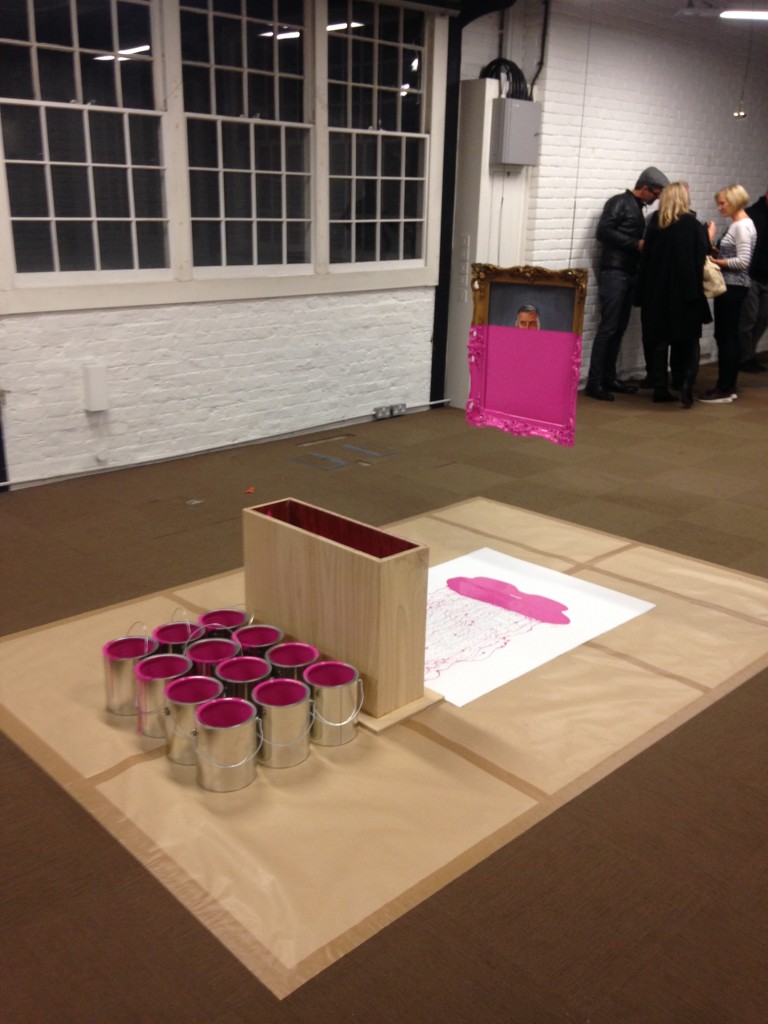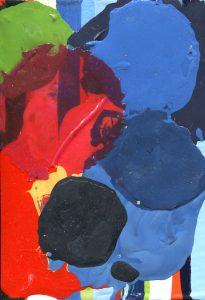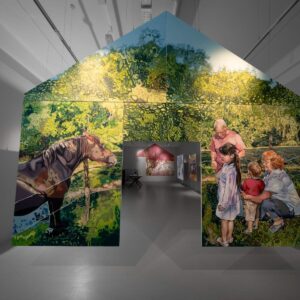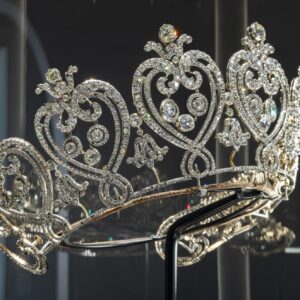FAD caught up with Irish New York artist Oliver Jeffers ahead of a crazy week of exhibitions and performance.
1. Oliver can you tell us about your work and what are the main ideas you try and express
My artistic practice is fairly evenly divided between my studio art and book illustration work, but I would say that there is a lot of thematic and material crossover between the two pursuits. Collage and typography, for example, play significant roles in many of my projects. Juxtapositions and dualities are also at the center of much of my work: perception and reality, playfulness and melancholy, rationality and emotion, loss and creation, et cetera.
As an example, I might compare The Incredible Book Eating Boy, one of my collage-based picture books, with my Dipped Paintings series. In the former, I created the illustrations using old discarded library books as the base. In my Dipped Paintings series, I create an entire original oil-on-canvas portrait that I subsequently dip into a vat of opaque enamel paint, permanently obscuring a large portion of the image. In both of these cases, an arguably destructive act leads to the creation of something new.
Also, while making that book, I was simultaneously working on a project called Additional Information with a Doctor of Quantum Physics which was about the quest in that field of trying to find the unifying theory of everything-the quest for ultimate intelligence. The Incredible Book Eating Boy is about one persons intention to become the smartest person on Earth.
2. How do you decide what your next artwork/project will be and how do you know when it is finished?
I am always working on new projects — new books, new paintings, commissions, experiments — some of which are tied to specific production schedules, and some of which are more flexible and organic. I think it’s important to always be able to prioritize time for free thinking and the exploration of new or one-off ideas, as these often form the basis of lengthier pursuits in the future. My current solo exhibition at Lazarides, Measuring Land and Sea, for example, is a continuation of two separate ideas that I first explored several years ago on a much smaller scale.
My schedule can admittedly be a bit demanding at times, especially when I am juggling multiple projects, but this also allows me to keep my energy up and avoid delays when I hit creative roadblocks. The nice thing about having lots of projects on at the same time is that if you experience any frustrations you can always move on to something else.
3. As well as having your exhibition at Lazarides you are doing a performance and Installation in Covent garden and a talk at The National Portrait Gallery – how did you manage to organise so much?
These projects are all the result of many months of planning, communication, and hard work. I am currently based in New York, but I grew up in Belfast, and London has always been an important city. This is my second solo show with lazarides, and I have been eager to show some of the Dipped Painting series in London for some time now, and I am very happy to have been able to get all of these events happening in such a small window of time. I also could not have managed to organize everything without the help of my studio team as well as the hard-working folks at Lazarides, the National Portrait Gallery, and Covent Garden.
4. Can you tell us about your exhibition Measuring Land and Sea at Lazarides
The work in Measuring Land and Sea originates with two earlier ideas, which I’ve been thinking about for years. I painted my first Protracted Landscape nearly a decade ago in response to a fascinating dialogue that I’d had with a quantum physicist. Our conversation led me to think about the limits of science and the possibility within scientific pursuits to over-analyze certain subjects, and I thought about painting a beautifully rendered landscape covered in numerical values representing measurements of angles present throughout the composition. These measurements, despite adding additional information to the piece, ultimately serve to distract from our appreciation of the landscape — additional factual information is not always necessarily productive.
I began working on the Fathom Seascapes a few years later following some research on ocean depth measurements. I decided to paint a seascape of a real-world location, and similarly add numerical text denoting the corresponding depth soundings in Fathoms. Not only is the fathom now an outdated unit of measurement, it also creates a bit of wordplay since the term can also mean ‘to understand’. Since the ocean is not flat, but in constant motion (as seen in the swells present in my seascapes), it is never truly measurable. These works are meant to speak to the futility of man in the face of the universe’s vastness.
I have never shown the two series together before this exhibition, but I feel that they naturally work alongside one another: one signifies a tendency to overanalyze, while the other reflects on the inability to fully comprehend nature. I hope that their combination in Measuring Land and Sea will speak to the forms of human cognition that the two series of paintings represent.
5. For people who haven’t heard about your dipped paintings could you tell us what themes you are trying to investigate in producing them.
The Dipped Paintings are part of an ongoing project that I have been working on since 2012. As the series currently exists, I paint a complete portrait which is never photographed, nor seen by anyone other than myself and its subject. The sitters for these portraits are all linked by the fact that they have experienced a death at close hand.
The portrait, once complete, is unveiled to a small invited audience who are ultimately the only people to view the full painting. After a short speech, the work is plunged into enamel paint, It is only through the eyes and memories of those present that the original painting will be documented. Once the dipping is complete, the witnesses are then asked to recall what they can remember of the painting during an on camera interview.
This project is, at its core, an experiment about memory and emotion. I am trying to include a wide cross section of humanity within both the selection of portrait subjects and witnesses, which is why I have been conducting the performances in different cities and countries.
6. Final question after all the stuff you have done in London whats next?
I have a few events and projects happening in New York during December, and then I will be enjoying Christmas with friends and family. After that, I will be spending some time in Los Angeles early next year to continue developing the Dipped Paintings project.
Dipped paintings No 11 will be on display at 31 Henrietta Street, London, from 18th-27th November.
Oliver Jeffers Measuring Land and Sea Lazarides 11 Rathbone Place London W1T 1HR
20th November – 23rd December 2015 Details
About The Artist
From figurative painting, collage and installation to cartography and picture-book making, Oliver Jeffers’ practice takes many forms. His distinctive oil paintings have been exhibited in multiple cities, including the Brooklyn Museum in New York and the National Portrait Gallery in London.
Curiosity and humour are underlying themes throughout Jeffers’ practice as an artist. As much about investigating the ways in which the human mind understands its world, his work is also executed as comic relief in the face of futility.
Oliver’s picture books are translated into over 30 languages with HarperCollins publishing them in the UK and Penguin in the USA. Titles include the New York Times Bestseller This Moose Belongs to Me, Stuck, How to Catch a Star and The Hueys.
Working in collaboration with Studio AKA, Oliver’s second book, Lost and Found, was developed into an animated short film, which has received over sixty awards including a BAFTA for Best Animated Short Film.
Oliver won an Emmy in 2010 for his collaborative work with director Mac Premo. Picture Book awards include the The New York Times Best Illustrated Books, Smarties Award, Irish Book of the Year, The Blue Peter Book of the Year, as well as shortlists for the British Book of the Year, The Roald Dahl Prize and the Kate Greenaway Medal. Born in Australia and brought up in Belfast, Northern Ireland, Oliver now lives and works in Brooklyn New York. www.oliverjeffers.com
















